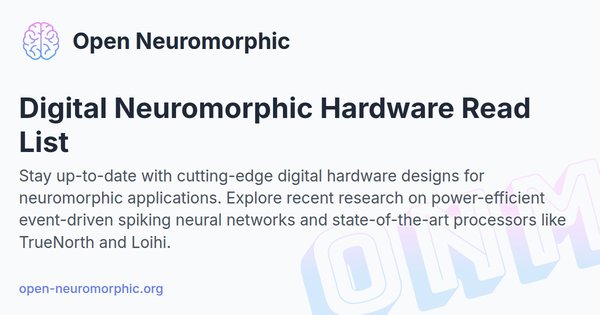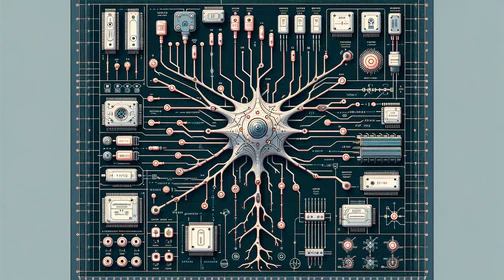
Here’s a list of articles and theses related to digital hardware designs for neuomorphic applications. I plan to update it regularly. To be redirected directly to the sources, click on the titles!
If you are new to neuromorphic computing, I strongly suggest to get a grasp of how an SNN works from this paper. Otherwise, it will be pretty difficult to understand the content of the papers listed here.
2015
TrueNorth: Design and Tool Flow of a 65 mW 1 Million Neuron Programmable Neurosynaptic Chip
TrueNorth: Design and Tool Flow of a 65 mW 1 Million Neuron Programmable Neurosynaptic Chip, Filipp Akopyan et al., 2015
This a fully digital chip, embedding 4096 cores with 1M neurons and 256M synapses!
It adopts a mixed design methodology: the local computational cores are synchronous, while the interconnecting infrastructure is asynchronous, i.e. event-driven. In particular, each core adopts time-multiplexing to compute the states of its neurons minimizing core area; each core has 256 neurons associated.
TrueNorth claims to be operating in real-time: a 1KHz synchronization signal is used to trigger the cores computations (state update, spikes processing, etc.). Moreover, they provide a software tool with one-to-one mapping to the hardware in order to deploy applications on it.
2018
Loihi: A Neuromorphic Manycore Processor with On-Chip Learning*
Loihi: A Neuromorphic Manycore Processor with On-Chip Learning, Mike Davies et al., 2018
Probably the most popular neuromorphic processor right now. What distinguishes it from the other ones are the online learning capabilities coupled with a completely asynchronous design: cores and routing network are completely clock-less!
Loihi supports local and scalable learning rules, through spike traces corresponding to filtered pre-synaptic and post-synaptic spike trains with configurable time constants, multiple state variables per synapse in addition to the weight value, reward traces. Moreover, several computational primitives are provided: addition of stochastic noise to the neuron’s synaptic current response; configurable and adaptable synaptic, axon and refractory delays; configurable dendtritic tree processing; neuron threshold adaptiation; scaling and saturation of synaptic weights.
The Loihi chip employs 128 neuromorphic cores, each of which consisting of 1024 primitive spiking neural units. Each Loihi core includes a programmable learning engine. Each core has an 2Mb SRAM memory on-chip, with ECC overhead included. The chip is fabbed in Intel’s 14nm FinFET process.
2019
A 0.086-mm2 12.7-pJ/SOP 64k-Synapse 256-Neuron Online-Learning Digital Spiking Neuromorphic Processor in 28nm CMOS
A 0.086-mm2 12.7-pJ/SOP 64k-Synapse 256-Neuron Online-Learning Digital Spiking Neuromorphic Processor in 28nm CMOS, Charlotte Frenkel et al., 2019
In this paper, a digital neuromorphic processor is presented. The Verilog is also open source! The processor is also known as ODIN.
The neurons states and the synapses weights are stored in two foundry SRAMs on chip. In order to emulate a crossbar, time-multiplexing is adopted: the synapses weights and neurons states are updated in a sequential manner instead of in parallel. On the core, 256 neurons (4kB SRAM) and 256x256 synapses (64kB SRAM) are embedded. This allows to get a very high synapses and neuron densities: 741k synapses per squared millimiters and 3k neurons per squared millimeters, using a 28nm CMOS FDSOI process.
The neuron model is programmable through an SPI interface: the user can choose among a LIF model (8 bits for the state of each neuron) and Izhikevic one (55 bits for the state of each neuron). Online-learning capabilities are allowed with an hardware-efficient implementation of the Spike-Driven Synaptic Plasticity (SDSP) rule.
The design is fully synchronous. The time evolution of the SNN implemented on the core can be tuned choosing changing the frequency of the time reference events, allowing to update the neurons states only when events actually take place.
The result is that each Synaptic OPeration (SOP) requires only 12.7pJ when the chip is powered with a voltage of 0.55V.
MorphIC: A 65-nm 738k-Synapse/mm2 Quad-Core Binary-Weight Digital Neuromorphic Processor With Stochastic Spike-Driven Online Learning
MorphIC: A 65-nm 738k-Synapse/mm2 Quad-Core Binary-Weight Digital Neuromorphic Processor With Stochastic Spike-Driven Online Learning, Charlotte Frenkel et al., 2019
In this work, a quad-core neuromorphic processor is presented.
The neuron model employed is the LIF one. Synapses are quantized down to 1 bit resolution, and online learning is allowed using a stochastic version of the SDSP rule. The chip is produced in 65nm CMOS, embedding 2k LIF neurons and 2M synapses, reaching a density of 738k synapses per squared millimeters.
The neurons interconnection is arranged in a hierarchical routing solution: mesh-based interconnectivity for out-of-chip communications; star-based connectivity for inter-core communications; crossbar-based interconnectivity for intra-core communications. 27 bits per neuron are allocated, allowing for a 1k neurons fan-in for each neuron, and 2k neurons fan-out for each neuron.
2020
Always-On, Sub-300-nW, Event-Driven Spiking Neural Network based on Spike-Driven Clock-Generation and Clock- and Power-Gating for an Ultra-Low-Power Intelligent Device
Always-On, Sub-300-nW, Event-Driven Spiking Neural Network based on Spike-Driven Clock-Generation and Clock- and Power-Gating for an Ultra-Low-Power Intelligent Device, Dewei Wang et al., 2020
In this work, a synchronous architecture is proposed. The logic operates at Near Threshold Voltage (NTV), and clock gating and power gating are heavily used to minimize power consumption during idle operation, which results to be 300nW. The chip is targeted at always-on applications, like keyword spotting (KWS); and it is prototyped on a 65nm CMOS process. The design is an only-inference one, with no online-learning capabilities.
The architecture belongs to the feed-forward category: 5 cores are used to implement fully connected spiking layers of Integrate and Fire (IF) neurons. To minimize power consumption, asynchronous wake-up circuits are employed to activate the layers only when there are incoming spikes.
On the GCSC and HeySnips datasets, the recognition accuracies are 91.8% and 95.8%, respectively. The total power consumption ranges between 75nW and 220nW.
2021
μBrain: An Event-Driven and Fully Synthesizable Architecture for Spiking Neural Networks
μBrain: An Event-Driven and Fully Synthesizable Architecture for Spiking Neural Networks, Jan Stuijt et al., 2021
This is an asynchronous digital architecture, with no online-learning capabilities provided. It is an inference-only chip.
The bit precision and network topology is chosen at synthesis time, while the neurons parameters and synapses weights can be programmed on chip. The neuron model employed is the Integrate and Fire (IF) one, with no leakage; the leakage can be added using an additional inhibitory input neuron to model it. A local clock is generated a neuron level when a spike arrives, so that the circuit consumes only static power when not operating. No time multiplexing is employed, the architecture is organised in a layer-by-layer fashion where all the neurons operate in parallel (i.e. each core corresponds to a neuron).
2022
Spiking Neural Network Integrated Circuits: A Review of Trends and Future Directions
Spiking Neural Network Integrated Circuits: A Review of Trends and Future Directions, Arindam Basu et al., 2022
Nice survey paper that compares different ICs, both digital and mixed-signal ones.
ReckOn: A 28nm Sub-mm2 Task-Agnostic Spiking Recurrent Neural Network Processor Enabling On-Chip Learning over Second-Long Timescales
ReckOn: A 28nm Sub-mm2 Task-Agnostic Spiking Recurrent Neural Network Processor Enabling On-Chip Learning over Second-Long Timescales, Charlotte Frenkel and Giacomo Indiveri, 2022
In this work, a Recurrent Spiking Neural Network (RSNN) processor is presented. The Verilog code is open source.
The key feature of this chip is the online learning capability, using a modified version of the feed-forward eligibility traces algorithm, which is a bio-inspired approximation of the BackPropagation Through Time (BPTT) algorithm employed for artificial RNNs. The chip performance is validated on gesture recognition, keyword spotting and navigation, with sub-150μW and sub-squared millimeter power and area budgets.
SNE: an Energy-Proportional Digital Accelerator for Sparse Event-Based Convolutions
SNE: an Energy-Proportional Digital Accelerator for Sparse Event-Based Convolutions, Alfio di Mauro et al., 2022
In this work, an only-inference digital chip is presented. The design is tuned towards event cameras output processing, employing convolution engines in the hardware.
The novelty of this design is that, even if it is a synchronous one, the number of operations performed is proportional to the number of events recorded by the camera, which allows very efficient inference when dealing with sparse inputs (e.g. low activity scenarios).
The design is validated on the IBM DVSGesture dataset, obtaining 80μJ per inference when classifying samples, with a recognition accuracy of 92.80% at most. This design is also integrated in the PULP platform; the SoC that embeds it is described in Kraken: A Direct Event/Frame-Based Multi-sensor Fusion SoC for Ultra-Efficient Visual Processing in Nano-UAVs, Alfio Di Mauro et al., 2022.
The SystemVerilog code is open source!
Sparse Compressed Spiking Neural Network Accelerator for Object Detection
Sparse Compressed Spiking Neural Network Accelerator for Object Detection, Hong-Han Lien and Tian-Shehuan Chang, 2022.
The neuron model employed in this work is a LIF one, with a delta-shaped synaptic kernel. The architecture topology is a feed-forward one, in which the neuron cores are arranged either is a cascade-fashion or in a configurable Processing Element (PE) array. The focus of this chip is to deal efficiently with the sparse nature of the activation maps in an SNN, by compressing the model with sparse data structures coupled with model pruning and 8 bits fixed point parallelism to reduce the on-chip memory requirement. The SNN architecture is mixed with an ANN one.
The final implementation, validated on an object detection task, achieves 29FPS when dealing with 1024x576 input frames; the throughput efficiency is 35.88TOPS/W and 1.05mJ/frame, running at 500MHz and being taped out on the TSMC 28nm CMOS process.
The object detection network is trained offline as ANN and then converted to an SNN, using the IVS 3 classes dataset and achieving 71.5% maP with on-chip inference.
Acknowledgements
I would like to thank Charlotte Frenkel for the valuable comments and suggestions.
Credits
The cover image is taken from Charlotte Frenkel’s thesis.
Have an idea? Share your voice.
Open Neuromorphic is a community-driven platform. We invite you to share your research, tutorials, or insights by writing a blog post.




